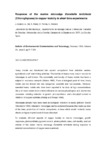Response of the marine microalga Dunaliella tertiolecta (Chlorophyceae) to copper toxicity in short time experiments

Use este enlace para citar
http://hdl.handle.net/2183/13844Coleccións
- Investigación (FCIE) [1259]
Metadatos
Mostrar o rexistro completo do ítemTítulo
Response of the marine microalga Dunaliella tertiolecta (Chlorophyceae) to copper toxicity in short time experimentsData
1995-02Cita bibliográfica
Abalde J, Cid A, Reiriz S, Torres E, Herrero C. Response of the marine microalga dunaliella tertiolecta (chlorophyceae) to copper toxicity in short time experiments. Bull Environ Contam Toxicol. 1995;54(2):317-24
Resumo
Heavy metals are introduced into aquatic ecosystems from industrial wastes, agricultural runoff and mining activities. The toxicity of heavy metal ions in solution to microalgae is well known. The essentiality and toxicity of heavy metals has been a subject of extensive research (Stokes 1983). From a biological point of view, heavy metals can be divided into two categories: essential and non-essential. However, essential heavy metals also have been reported to be toxic at high concentrations. Many of these metals have a direct influence on various physiological and biochemical processes including reduction in growth, photosynthesis, and chlorophyll content or inhibition of enzyme activities (Reddy and Prasad 1990).
Microalgae already have been used as biological indicators to assay pollutant toxicity (Hornstrom 1990). Interest in microalgae can be explained because they make up most of the base production of marine ecosystems, a base which would probably cause effects on higher trophic levels if it was disturbed.
To evaluate different aspects of copper toxicity to marine microalgae, growth responses, photosynthetic pigment content, photosynthetic rates, cell viability, and cell volume of the naked marine microalga Dunaliella tertiolecta during exposure to selected concentrations of copper were examined.
Palabras chave
Heavy metals
Aquatic ecosystems
Toxicity
Microalgae
Dunaliella tertiolecta
Copper
Copper concentrations
Aquatic ecosystems
Toxicity
Microalgae
Dunaliella tertiolecta
Copper
Copper concentrations
Versión do editor
Dereitos
The final publication is available at link.springer.com





